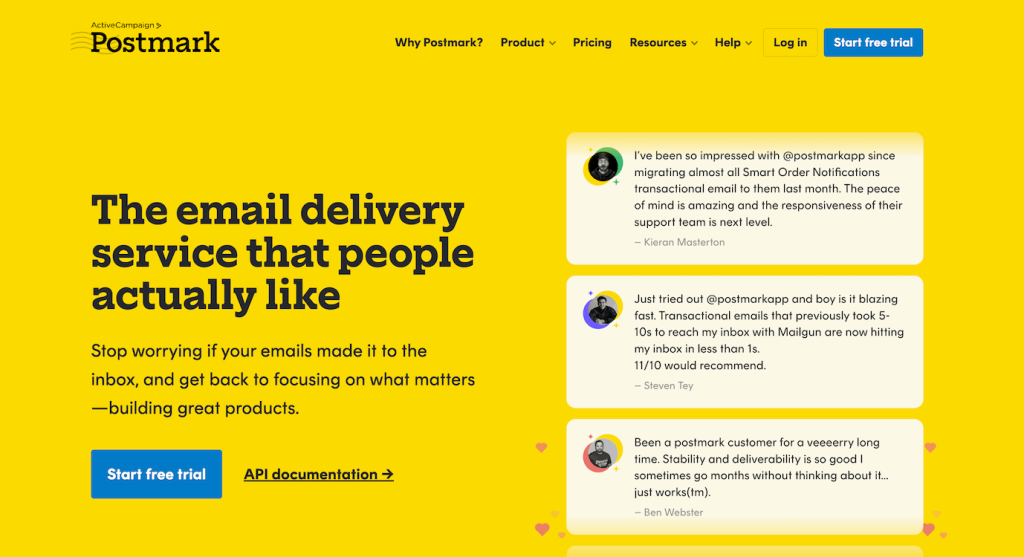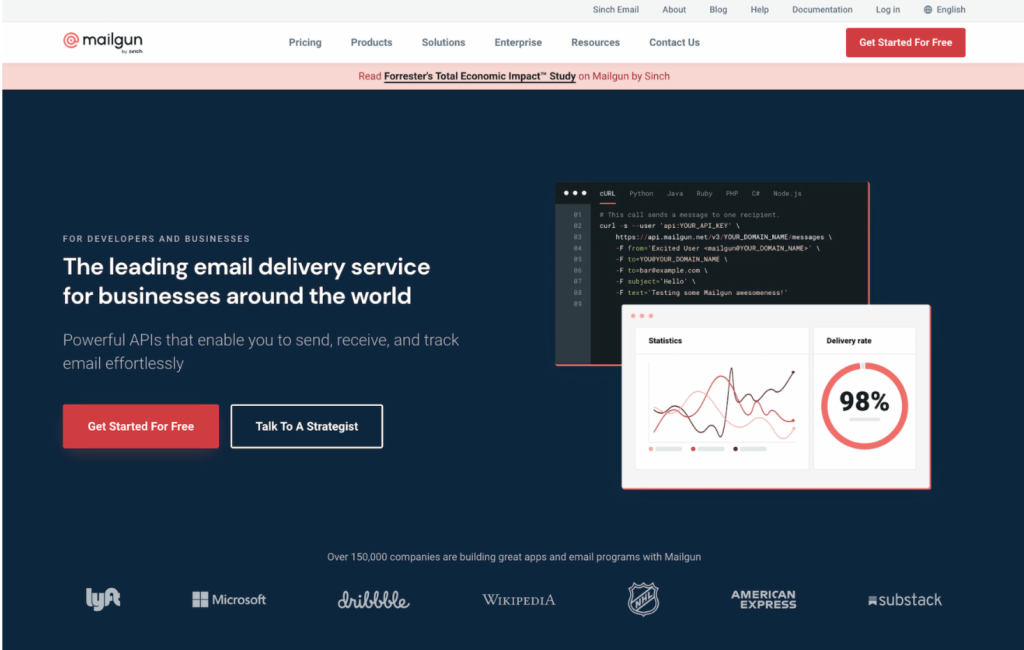Looking for an effective Amazon SES alternative for sending bulk emails? Amazon SES, also known as Simple Email Service, can seem simple, just like its name, but only on the surface. Although their SMTP service is of good quality and the pricing structure is very inexpensive, the rules and restrictions can be bothersome to users. Especially, getting out of Amazon SES sandbox can be really tiresome and time consuming. Hence, many users want to opt for an Amazon SES alternative.
In this blog, I will compare and discuss three SMTP providers, Postmark, Mailgun, and SMTP2GO, as alternatives to Amazon SES. Read on and find out which one suits your business the best!
Table of contents
- Amazon SES Alternative: Postmark, Mailgun & SMTP2GO Overview
- Amazon SES
- Amazon SES Alternatives
- Postmark
- Mailgun
- SMTP2GO
- Features: Amazon SES vs Postmark vs Mailgun vs SMTP2GO
- Costing Examples: Postmark vs Mailgun vs SMTP2GO Pricing
- Wrap Up
- FAQ on Amazon SES Alternatives
Amazon SES Alternative: Postmark, Mailgun & SMTP2GO Overview
Before diving into the main discussion, let’s have a glimpse at three Amazon SES alternatives. Check out this Postmark, Mailgun, and SMTP2GO overview.
| Facts | Postmark | Mailgun | SMTP2GO |
|---|---|---|---|
| Best known for | Transactional emails and high deliverability | Excels in email management and handling high-volume emails | High email deliverability |
| Free pricing plan | Yes (Designed for developers’ testing purposes.) | Yes | Yes |
| Free trial | Yes | Yes | No |
| Paid plans | Starting from $15/mo for up to 10K emails | Starting from $15/mo for up to 10K emails | Starting from $15/mo for up to 10K emails |
| Customer support | Email & chat, phone support | Email & chat support | Ticket, chat, and phone support |
| G2 rating | 4.6⭐ | 4.2⭐ | 4.7⭐ |
Let’s first bring a brief overview of Amazon SES for comparison convenience.
Amazon SES
What is Amazon SES? It’s an AWS email service; the Amazon Simple Email Service, or in short, Amazon SES, is a cloud-based email service that lets apps send both transactional and marketing emails. It’s very scalable, stable, and cost-effective, and you can pay as you go. For sending bulk emails, Amazon SES integrates with multiple programs and offers the necessary features to enhance speed, including content filtering, email authentication, and deliverability dashboards.
Learn in depth about: AWS Email Service: Configure, Types & Pricing
Key Amazon SES features
- SMTP
- API
- Analyze email deliverability
- Integration
- Virtual deliverability manager
- Mail manager
- Sender identity management and security
- Reputation dashboard, etc.
Amazon SES Pricing
You know, Amazon SES pricing is popular for being one of the most affordable options. Amazon SES offers 3,000 emails (per month) for the first year. Apart from that, AWS SES pricing for email sending costs $0.1 per 1000 emails ($0.0001 per email). No doubt Amazon SES pricing is the cheapest option ever!
Note: Their email sent volume costs are based on the number of emails you send. In other words, they follow a pay-as-you-go (PAYG) approach.
Amazon SES pricing has two types of plans:
| Email sent volume | Pricing |
|---|---|
| For the initial 3,000 emails sent every month (only for the first year) | Free, $0 cost |
| After surpassing the 3,000 monthly limit | $0.1 for 1,000 emails ($0.0001 each email) |
Note: The free tier is only applicable for the first 12 months.
Get a detailed idea of pricing combining MailBluster and Amazon SES:
MailBluster and Amazon SES Pricing: Underpriced Combo Ever!
Why explore other SMTPs instead of Amazon SES?
As mentioned at the beginning, getting out of the Amazon SES sandbox is no easy task. So, what is it? When you sign up, your AWS account remains in the “Sandbox” mode. And when you are in this mode, you can only send 200 emails a day to the Amazon SES mailbox simulator and verified email addresses and domains. And oh, you can’t send emails to more than one recipient at a time.
You have to follow specific guidelines to convince them to get you out of the sandbox. They do it to protect their email security by minimizing spam and safeguarding their reputation, which is understandable. But all these rules and limitations make this supposedly cheapest SMTP provider difficult to use. Therefore, if you don’t want to face such difficulties, then you need to choose an Amazon SES alternative.
Amazon SES Alternatives
Now, moving to the main attraction of the topic! Let’s explore the best Amazon SES alternatives for SMTPs.
Postmark
Check out Postmark as an alternative to Amazon SES:

What is Postmark? Launched in 2009, Postmark is an email delivery and management platform. However, they initially focused only on transactional emails, but since 2009, they have expanded their sending infrastructure to send both transactional and marketing emails. Their SMTP and API services are great, ensuring high deliverability. Plus, they provide tracking and analytics tools to assist businesses in improving their email performance.
What is Postmark best for?
Postmark is best for continuous delivery of both transactional and marketing emails, which are handled by two different message broadcast streams. They also offer extensive developer support, including strong APIs, in-depth analytics, and a robust template library. You may easily configure your application to use Postmark SMTP servers for email delivery, just like any other standard SMTP server.
Key Postmark features:
- SMTP service
- Email API
- Message streams
- Rebound
- Analytics
- Email experts
Postmark pricing
Postmark pricing offers 3 plans, each with a set number of emails at a specific monthly cost.
Basic: $15 per month for 10,000 emails and $1.80 for each extra 1,000 emails.
Pro: $60.50/month for 50,000 emails, plus $1.30 for 1,000 emails.
Platform: $138 per month for 125,000 emails; $1.20 for 1,000 emails.
Additionally, aside from these three pricing tiers, Postmark offers a free testing tier designed explicitly for developers.
Free Developer tier: 100 emails per month at $0 for testing. It’s a free plan for life, but with limited features.
Note that the cost of each extra email in Postmark drops as you move to larger volume plans.
Pros of Postmark
Why should you use Postmark? Let’s go over the pros!
- User-friendly interface.
- It ensures fast email delivery and high deliverability.
- Provides top-notch SMTP service.
- Transparent pricing structure.
- Offers developers a free tier for testing purposes.
- Has separate message streams for transactional and marketing emails, ensuring top-notch quality for both streams.
- Transactional and marketing emails don’t mix; remain separate.
- Excellent documentation.
- Provides essential analytical insights.
- 45 days of data retention for delivery events, bounces, opens, and clicks.
- Provides reliable customer support through email, 1-on-1 calls, and live chat with no extra charge.
- Has a high customer happiness rate of 86%.
Cons of Postmark
Let’s go over the cons!
- Limited features, such as no marketing automation.
- Quite pricey.
- Focuses mainly on email delivery and not management.
- Keeps data only for 45 days.
- Limited developer free tier, 100 emails per month only.
- No SMS or digital marketing add-ons.
- Not email template-builder friendly.
Mailgun
Check out Mailgun as an alternative to Amazon SES:

What is Mailgun? Mailgun, often referred to as Sinch Mailgun, was launched in 2010. It is an email service that enables sending, receiving, and tracking emails. They mainly claim to be a transactional email delivery service, but they are not limited to that. It provides a powerful API and SMTP service, making it suited for both transactional and large-scale email marketing campaigns. Mailgun helps in increasing email deliverability and provides extensive analytics.
What is Mailgun best for?
Mailgun is best known for its API, SMTP relay, and email validation functions. Though their features can seem very limited for email marketing, email marketing platforms can easily set up Mailgun SMTP, just like any other SMTP service. And enjoy all the advanced features through the email marketing platform to run successful email campaigns.
Key Mailgun features
- SMTP relay
- Send email API
- Message streams
- Email validation
- Mailing list
- Email list validation
- A/B testing
- Basic email template builder
Mailgun Pricing
Mailgun pricing has 4 plans; each of which includes a specified quantity of emails at a specific monthly cost.
Free: $0/month for 100 emails per day.
Basic: $15/month for 10,000 emails. And $1.80 per extra 1,000 emails.
Foundation: $35/month for 50,000 emails. And $1.30 per extra 1,000 emails.
Scale: $90/month for 100,000 emails. And $1.10 per extra 1,000 emails.
Note: The cost per additional email drops as you move to a larger volume plan.
Pros of Mailgun
Why should you use Mailgun? Let’s go through the pros!
- Ease of use.
- It’s reliable for email delivery and increasing email deliverability.
- Provides a good SMTP service.
- Ensures high email deliverability.
- Provides helpful features, such as email validations, to verify email lists.
- Offers a free plan.
- Provides advanced analytics: detailed analytics on email sending.
- Provides scalability: capable of handling high volumes of email traffic.
- Provides extensive customization options for email functionality, including email templates.
Cons of Mailgun
Let’s go through some of the cons!
- Limited email marketing features.
- Quite expensive.
- Not beginner-friendly: technical complexity and setup.
- Unrigid customer support: can be slow and available only in English.
SMTP2GO
Check out SMTP2GO as an alternative to Amazon SES:

What is SMTP2GO? SMTP2GO is an email delivery service provider that offers large-scale email sending, tracking, and management via the Simple Mail Transfer Protocol (SMTP). It is well-known for sending and managing transactional and promotional emails. It offers tools for monitoring email deliverability, performing performance analysis, and ensuring that your emails reach their intended recipients correctly.
What is SMTP2GO best for?
SMTP2GO is best for its SMTP service. It stands out especially with its high email deliverability rates, along with a very user-friendly interface and detailed tracking and reporting features. Plus, SMTP2GO focuses on providing customer-centric features and cost-effective solutions.
SMTP2GO key features:
- SMTP relay
- Powerful deliverability
- Automatic DKIM/SPF
- Integrations
- Reporting
- Customer support
SMTP2GO Pricing
SMTP2GO pricing has 3 plans; each of which includes a specified quantity of emails at a specific monthly cost.
Free: $0/month for 1000 emails per month.
Starter: $15/month for 10,000 emails. And $1.80 per extra 1,000 emails.
Professional: $35/month for 50,000 emails. And $1.30 per extra 1,000 emails.
Note:
- SMTP2GO provides a custom service called the Premier plan for sending 3,000,000+ emails.
- The cost per additional email drops as you move to a larger volume plan.
Pros of SMTP2GO
Why should you use SMTP2GO? Let’s go through the pros!
- Excellent SMTP service
- Fast email delivery
- Provides high deliverability
- Ease of use: scored highest- 9.4
- Ease of setup: scored the highest in quality- 9.3
- Affordable pricing plans
- Offers a free plan
- Outstanding customer support: scored highest- 9.2
Cons of SMTP2GO
Now, let’s go through some of the cons!
- Limited features
- Restrictions in the free plan
- Limited automation capabilities
Features: Amazon SES vs Postmark vs Mailgun vs SMTP2GO
Here is a feature comparison table chart of Amazon SES, Postmark, and Mailgun based on key features significant to email senders:
| Feature | Amazon SES | Postmark | Mailgun | SMTP2GO |
|---|---|---|---|---|
| SMTP support | Yes | Yes | Yes | Yes |
| API support | Yes | Yes | Yes | Yes |
| Deliverability | Good | High priority | Very good | High |
| Analytics and reporting | Basic | Detailed | Detailed | Detailed |
| Inbound email | Yes | Yes | Yes | Yes |
| User interface | Minimal | Clean and intuitive | Modern and user-friendly | User-friendly |
Compare the features of these three SMTP providers to determine which one best suits your business needs. All three, Postmark, Mailgun, and SMTP2GO, offer various essential user-friendly features, unlike Amazon SES.
As you can see, these Amazon SES alternatives are very similar in features, with just slight differences in quality. For example, both Postmark and SMTP2GO give high priority to increasing email deliverability, and as mentioned earlier, their deliverability rate is very high. Although Mailgun’s deliverability is not as high as Postmark and SMTP2GO, it is still of very good quality, according to several reviews.
Let’s go through a pricing chart for these 3 SMTPs so you can find it easier to make a decision.
Costing Examples: Postmark vs Mailgun vs SMTP2GO Pricing
Moving on, let’s examine the pricing chart based on email sending volume with the suitable paid plans.
| Email sending/month | Mailgun | Postmark | SMTP2GO |
|---|---|---|---|
| 10,000 | $15 (with Basic plan) | $15 (with Basic plan) | $15 (with Basic plan) |
| 50,000 | $35 (with Foundation plan) | $55 (with Basic plan) | $30 (with Starter plan) |
| 100,000 | $75(with Foundation plan) | $115 (with Basic plan) | $75 (with Professional plan) |
| 250,000 | $215 (with Scale plan) | $245 (with Basic plan) | $170 (with Professional plan) |
As seen from the pricing chart, all three options— Postmark, Mailgun, and SMTP2GO—are more expensive than Amazon SES pricing. However, the ease and features these three SMTPs provide, unlike Amazon SES, make it worthwhile.
All three have very similar pricing, with slight differences. As you can see, Mailgun and SMTP2GO pricing appear to be somewhat lower than Postmark pricing. So choose one according to your budget plan.
To get more detailed ideas on pricing for these three SMTPs, combining with MailBluster, read:
- MailBluster and Postmark Pricing Combo: Taking a Close Look
- MailBluster & Mailgun Pricing Combo: 6 Calculative Examples
- MailBluster and SMTP2GO Pricing Combo: 5 Costing Examples
Verdict
When evaluating Amazon SES alternatives as an SMTP, ensure they offer top-notch deliverability, ease of use, and essential features. Postmark, Mailgun, and SMTP2GO are excellent SMTP providers, and they share a very similar pricing structure and feature set, with only a few notable differences. So, it depends on you, your business’s requirements, and your budget. Therefore, choose accordingly, and as all three are good, whichever one you choose would be a good decision for the long run.
Wrap Up
Postmark, Mailgun, and SMTP2GO are well-known as SMTP providers and can be beneficial as an Amazon SES alternative. This blog explains why and how these three SMTP providers can be a great choice, mainly due to their essential features. However, to excel in email marketing, you still need more advanced features to run and execute various email campaigns, such as welcome emails and dynamic email campaigns. No worries. Simply integrate your Postmark, Mailgun, or SMTP2GO SMTP with MailBluster and enjoy seamless and insightful email marketing from start to finish!
For SMTP connecting guidelines, read:
How to Connect MailBluster with Postmark, Mailgun & SMTP2GO
FAQ on Amazon SES Alternatives
Yes, Postmark, Mailgun, and SMTP2GO provide a free tier. All three are mainly suitable for developers and testing purposes.
No, Mailgun usually doesn’t provide phone support; it is only available for premium users.
The Amazon SES Sandbox limit is 200 emails per day for email sending. And you can send to only verified email accounts.
No, Postmark and Mailgun do not have conditions such as AWS SES Sandbox.
Yes, both Postmark and Mailgun offer free trials, making it more convenient to test as an alternative to Amazon SES.
No, there are no setup fees or hidden charges in Postmark and Mailgun.



 Contents
Contents